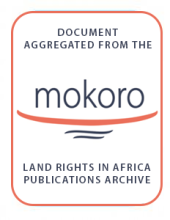/ library resources
Showing items 1 through 9 of 9.This 78-page Policy (replacing with small but significant changes earlier versions) was approved by Cabinet on 17 January 2002. A summary of main policy recommendations is followed by 10 chapters: 1. Introduction; 2. Historical evolution of land policy; 3. Overview of land problems; 4.
Includes background information; government policies on agriculture and land use; challenges in land planning; landlessness, investment and market driven land planning; the Uganda Land Alliance work on natural resources and land use planning; examples of environmental and industrialization confli
Looks at land use planning challenges in the Arid and Semi-Arid Lands (ASALs) of Kenya – lack of coherent vision, disconnect between political and technical planning processes, urgent needs of ASALs not being considered, lack of investment, National Land Commission under-resourced, conflicts over
Equitable access to land is vital for inclusive economic growth, sustainable development and food security. Much is known about the topics of land governance and food security, but it is not always clear how the two relate to each other, especially in specific country contexts.
A review of all Botswana land-related policies in preparation for a comprehensive new National Land Policy. Covers land rights, land markets and taxation, urban and rural land management, land use planning, legal, institutional and financial issues.
The future is increasingly urban and inevitably so. Urbanisation is increasing at unprecedented rate in both Sub-Saharan Africa and developing world (UN Habitat, 1999).
The history of surveys and mapping in Tanzania has been influenced by two European cultures through its colonization; first by the German and then by the British.
The aim of this paper is to compute a more accurate orthometric height of Mount Kilimanjaro by utilizing the current most precise geoid model for Tanzania, TZG08, together with the 1999 and 2008 GPS campaigns ellipsoidal heights using GPS levelling method.
The practice of food security assessment in Tanzania is based on use of food crops production data surveys of a preceding seasonal year with agro-meteorological analyses based on estimated vegetation status as reflected from NDVI computed from NOAA satellite images.
Land Library Search
Through our robust search engine, you can search for any item of the over 73,000 highly curated resources in the Land Library.
If you would like to find an overview of what is possible, feel free to peruse the Search Guide.





